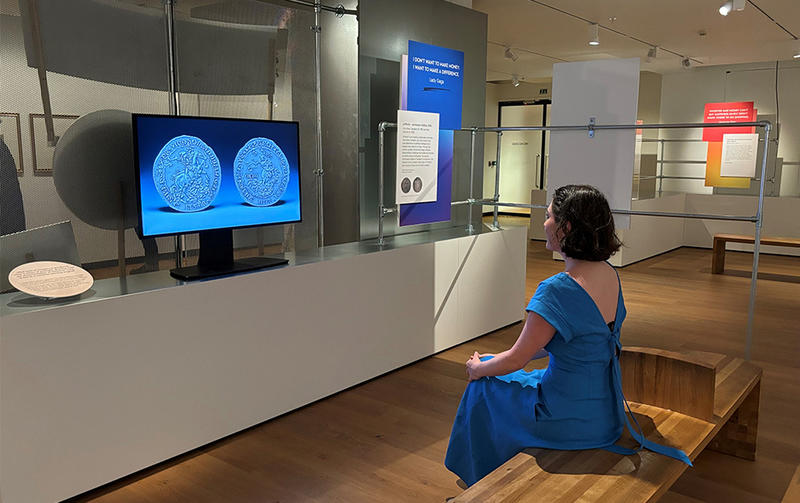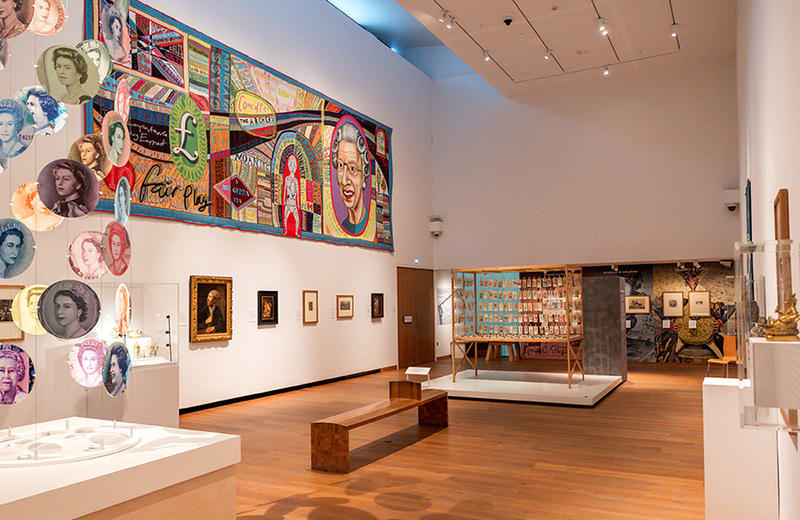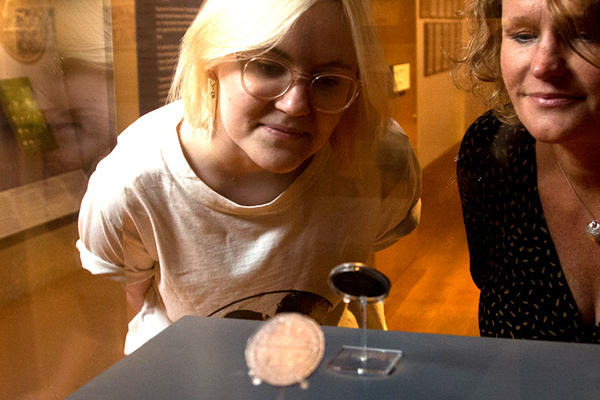A NEW OXFORD CROWN FOR THE AGE OF AI & NFTs
4-minute read
By Alex Estorick and Ana María Caballero
Media theorist and literary artist, creators of the long-form generative AI project artifacts
With Dr Shailen Bhandare, curator of the Ashmolean's Money Talks exhibition
We asked the creators of the new 'alternative' Oxford Crown NFT, currently on show in the Ashmolean's Money Talks exhibition, to tell us about their artwork and introduce us to NFTs and AI in art. The Oxford Crown coin NFT is on display in the end gallery of the exhibition which looks at artists' responses to money in a 'futuristic' manner. It's the first original NFT in the Museum's collection.
Here's a little explanation of what an NFT actually is before you read the Q&A below:
An NFT (non-fungible token) is a unique data file, which cannot be copied. It is stored on a digital ledger called ‘blockchain’, which is in effect an advanced ‘open source' ledger of transactions, that anyone can ‘see’. The NFT is encoded with the same software that is used in cryptocurrencies like ‘bitcoin’. The uniqueness of an NFT combined with the technological association with the same software that creates digital currencies, makes it a ‘token of value’ and so, tradeable as ‘money'. Turning files into NFTs helps secure them, via blockchain, to make buying, selling and trading efficient, while reducing fraud considerably.
Why create NFTs?
Alex Estorick: Digital art was the proof of concept for NFTs. It could have been music or another art form, but due to pent-up demand and the online dependency fostered by the pandemic it was digital art. According to the artist and writer Mitchell Chan, NFTs separate an artwork’s 'artistic form' (the media eg a JPEG) from its 'commodity form' (the token).

CryptoPunk #780, NFT, created by Larva Labs, on show in the Money Talks exhibition. Courtesy of Larva Labs
The implications of NFTs for art and the wider cultural economy are seismic. Not only have they helped to engineer an entirely separate, natively digital, art world, they have also altered the central premise of art from an object to be displayed to a token to be transacted.
How did the Money Talks commission come about?
Alex Estorick: I am a long-standing collaborator with Foteini Valeonti, who advised on the final section of the Money Talks exhibition. Together, we have developed a curatorial studio reGEN to support generative artists, working with code, in fighting degenerative diseases, raising money for charities around the world.
From the beginning, Ana and I always wanted our long-form generative AI project, artifacts (2023–ongoing), to serve as a gateway to greater critical understanding of AI. We also viewed it as a tool for museums to introduce audiences to the prospect of hybrid human-machine cultures.
Ana and I approached the Museum’s curators through Foteini with a view to developing a new version of the work to coincide with Money Talks, and we were overjoyed when they commissioned us to produce a new edition of the project – the first work of digital art in the Ashmolean’s collection.

The AI-generated Oxford Crown NFT display in the Money Talks exhibition
Dr Shailen Bhandare, Money Talks curator: I was interested in knowing and showing what artists, who work in the realm of digital art, find most exciting with regard to how the technology becomes a medium for their artistic engagement, rather than the coverage art like NFTs get for their market volatility and seemingly ‘childish’ outputs. Understanding this 'metaverse' is not easy – however there are a lot of us out there who not only do but also thrive in it. We hope that the futuristic section in the Money Talks show will appeal to them.
Why the Oxford Crown coin as the Ashmolean Edition of artifacts?
Ana María Caballero: When we received confirmation that we would be contributing an edition of artifacts to the Money Talks Ashmolean exhibition, we began looking through the Museum’s coin collection in search of a good candidate to 'rewrite'.
Our original artifacts project, released in 2023, used a diverse array of ancient coinage as its source material, replacing their narratives with new ones: inscribing tokens with scenes of domesticity, including pregnant women reading as well as public expressions of joy. Using generative AI, we insert unexpected stories onto digitally generated coins in order to question what and who is valued by society.

Oxford Crown, front and reverse, struck at the Oxford Mint in 1644
The Oxford Crown coin immediately stood out for several reasons. It is strongly rooted in Oxford, and we wanted our Ashmolean Edition to reference its place of origin specifically. It was minted in Oxford, when King Charles I moved his court to Oxford in 1642-46, during the English Civil War. The coin in the Museum’s collection is also well-preserved, which made it a good candidate for an AI source image. Finally, its iconography is ripe for subversion.
Dr Shailen Bhandare: Designed by Thomas Rawlins, the Oxford Crown bears Charles’s equestrian portrait. Below the horse, one can see the Oxford skyline, with several identifiable buildings. The reverse dates the coin to 1644 and advertises Charles’s aims in the Civil War – to uphold the Protestant religion, the laws of England and the freedom of Parliament. The writing around is from Psalm 68: 'Let God arise, let his enemies be scattered'.
The Oxford Mint was set up at New Inn Hall, at the present site of St Peter’s College, in January 1642. Stocked with silver from Oxford and Cambridge colleges, the Oxford Mint managed to cover Charles’s needs for coinage in his war effort. Around 10 Oxford Crowns exist today – two are in the Ashmolean collection.
What are the key features of the artifacts–Ashmolean Edition of the Oxford Crown?
Ana María Caballero: We were eager to knock the king off his horse, replacing its static and iconic image with a form of narrative coinage depicting a female figure in flux, even metamorphosis.

artifacts–Ashmolean Edition, Oxford Crown NFT, Ana María Caballero & Alex Estorick, 2024, Single-edition generative AI. Courtesy of the artists
The inclusion of carnations references the tradition of students at Oxford University wearing flowers on their lapels when taking their final exams. In this way, our coin nods to education and knowledge as alternative stores of power, rather than the might of an inherited crown.
Unlike the original collection of 100 artifacts, released last year with Emprops (a digital art platform and creative studio), this work is a special site-specific commission for the Museum that includes a recto and a verso.
Dr Shailen Bhandare: We are delighted with the artifacts–Ashmolean Edition of the Oxford Crown, not simply because it is our first ever digital art acquisition, but also because it makes a pertinent intervention for the narrative of the Money Talks exhibition. By subverting some of the original iconography of the Rawlins design, Alex and Ana have made an important comment about the importance of education. The overarching theme for the third gallery in the exhibition is about how artists use money as a medium in playful, provoking and futuristic ways. Since artifacts–Ashmolean Edition blurs the boundaries between art and money through its digital technique, it fits perfectly in the futuristic story.
How do you feel being in the Money Talks exhibition?
Alex Estorick: It’s tremendously exciting to be featured alongside such a remarkable collection of exchange media from around the world.

Inside the Money Talks exhibition, in gallery 2
We are proud to be flying the flag for a digital art community that doesn’t always get the recognition it deserves from a public still sceptical about NFTs and cryptocurrency.
From our perspective, what makes this show important is the way it frames art in an expanded sense, as part of a history of the image (and coinage) distributed throughout society, not simply confined to a white cube.
Dr Shailen Bhandare: Digital art and in particular NFTs mark the ‘next frontier’ in how artists creatively and critically engage with our world. The Ashmolean has always welcomed artists to study the objects in our collection and ‘respond’ using them as inspiration. Conventionally, artists would do this using familiar mediums, techniques and tools. Digital artists replace paint, brush and canvas with computer coding and AI. The technology now allows them to even claim and ‘monetise’ their copyright. Such transformations go to the very heart of what we consider, collect and critique as ‘Art’.
What's the future for digital ownership in the art world?
Ana María Caballero: As our lives become increasingly digitised, so too will our assets. The day will arrive when we will no longer differentiate between digital and physical ownership.
The Money Talks exhibition documents the evolution of money, with digital currency enjoying a final say. To us this signals the growing financial and cultural clout of digital ownership. Digital certificates will increasingly accompany physical artworks, not just as records, but as expansions of the original work.
artifacts has been nominated for The Lumen Prize 2024 for artists working in technology.

Find out more about The Lumen Prize 2024 finalists








